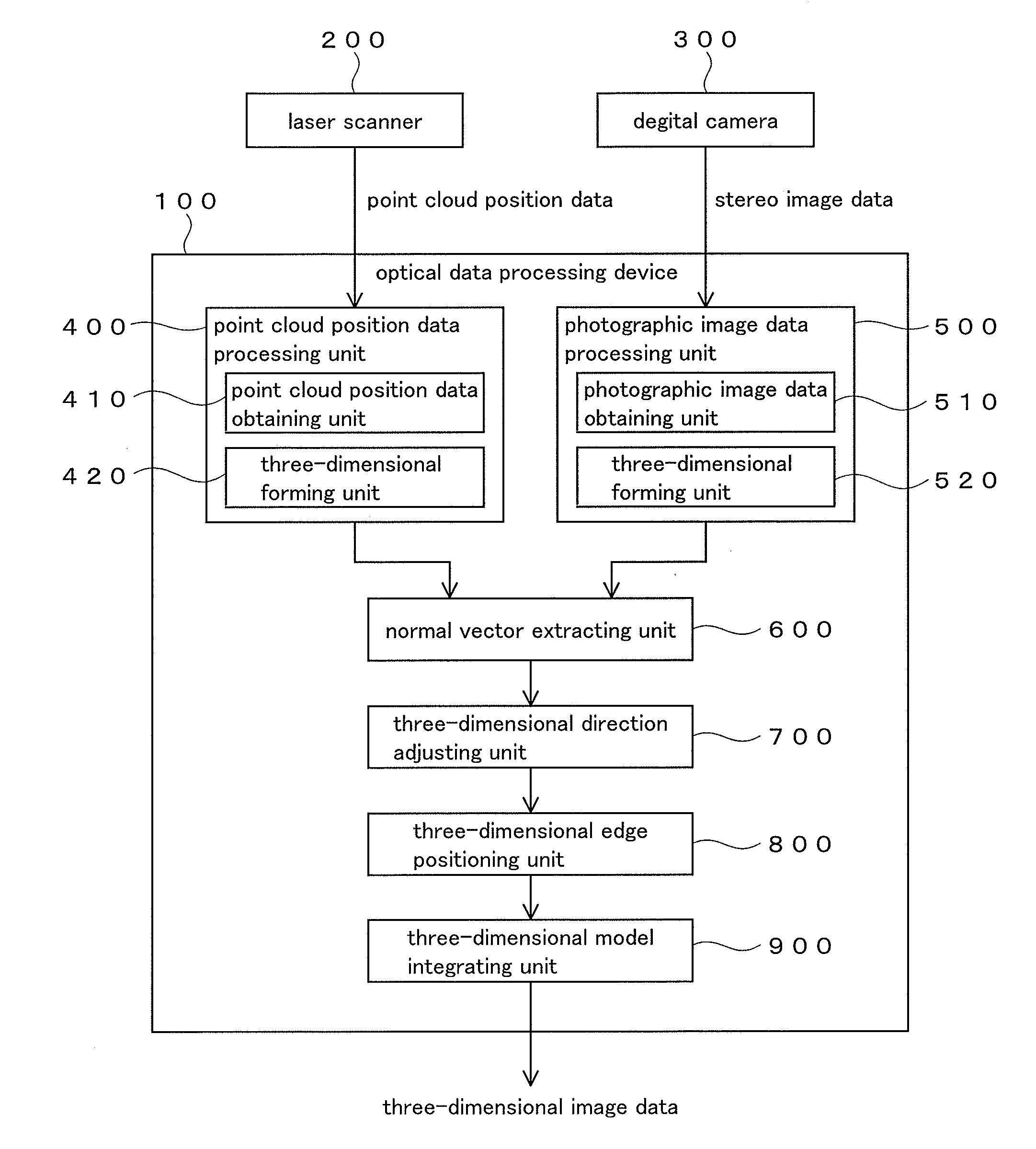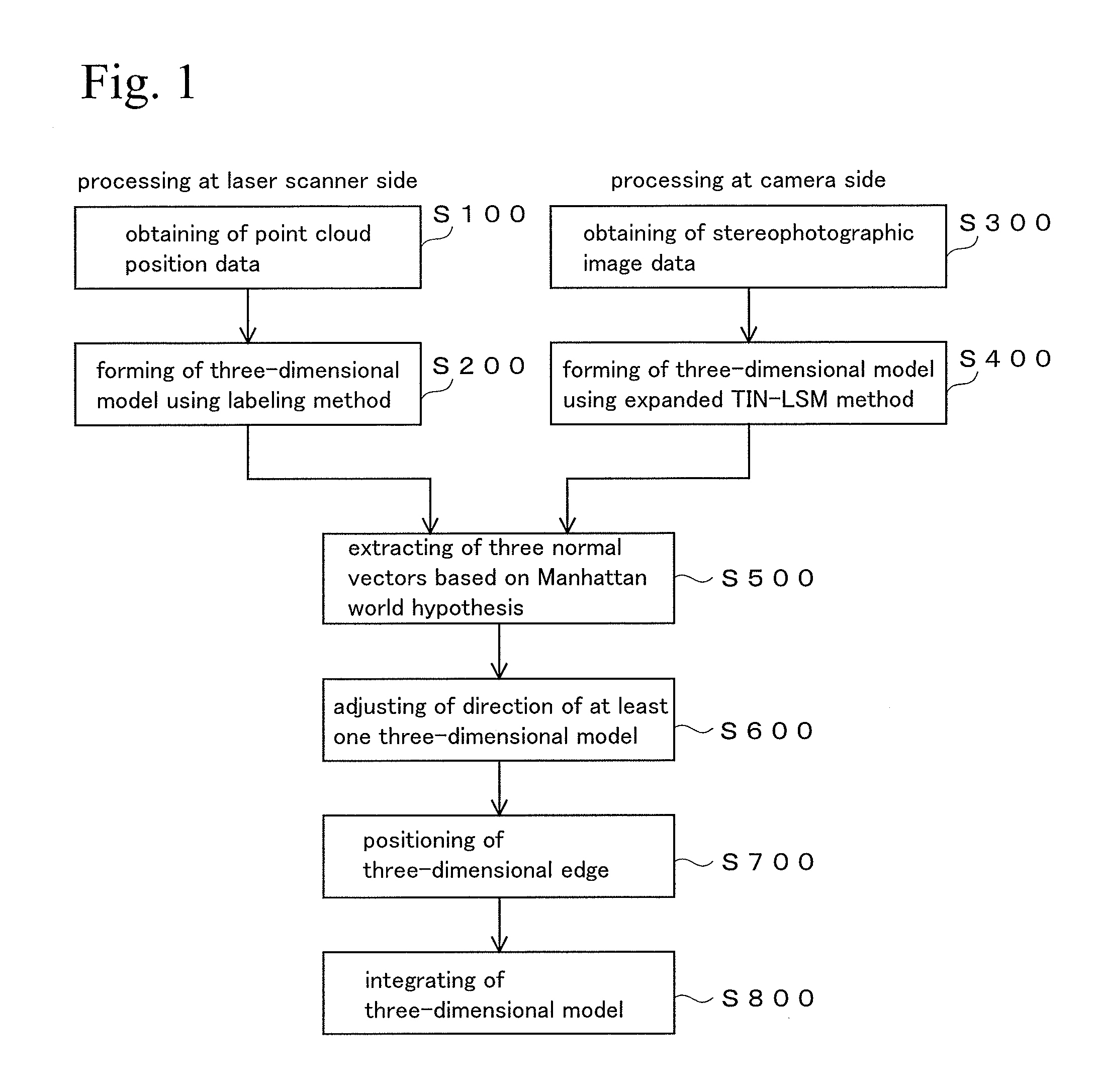Optical data processing device, optical data processing system, optical data processing method, and optical data processing program
a technology of optical data processing and optical data, applied in the field of optical data processing techniques, can solve the problems of inability to obtain point cloud position data of a part, occlusion generated by flickering images of passersby, and inability to obtain it, and achieve the effect of high precision
- Summary
- Abstract
- Description
- Claims
- Application Information
AI Technical Summary
Benefits of technology
Problems solved by technology
Method used
Image
Examples
first embodiment
1. First Embodiment
Assumption
[0043]The main objects to be measured in the present embodiment are buildings.
DEFINITION OF TERMS
[0044]In the following, the terms used in the specification will be explained.
Labels
[0045]The labels are identifiers for specifying a plane (or for distinguishing from other planes). The plane is a suitable plane for selecting as an object to be calculated, and it includes a flat surface, a curved surface having large curvature, and a curved surface having large curvature and small change at a curved position. In this specification, the plane and a non-plane are distinguished based on an allowable calculating amount that is mathematically understood (obtained from data) by calculation. The non-plane includes a corner, an edge part, a part having small curvature, and a part having large change at a curved portion. In these parts, a large amount of the mathematically understood (obtained from data) calculation is required, and burden on a calculation device and...
second embodiment
2. Second Embodiment
[0151]In the first embodiment, the case in which a main three-dimensional model is a laser point cloud three-dimensional model and an image measuring three-dimensional model is used in order to compensate for a part in which occlusion is generated in the laser point cloud three-dimensional model, was explained. Conversely, the image measuring three-dimensional model may be a main three-dimensional model and the laser point cloud three-dimensional model may be used for compensating in the main model. In this case, a procedure of the processing is the same as that of the First Embodiment. It is difficult for an object range of the image measuring three-dimensional model to be wider and a part of the range (including a part in which the occlusion is generated, a part having low accuracy, etc.) is compensated for by the laser point cloud three-dimensional model.
[0152]In this case, the image measuring three-dimensional model may not have an actual scale as described i...
third embodiment
3. Third Embodiment
[0154]Both of two three-dimensional models to be integrated may be laser point cloud three-dimensional models. In this case, the laser scanning is carried out from each of different viewpoints, a first laser point cloud three-dimensional model and a second laser point cloud three-dimensional model are obtained, and these two three-dimensional models are integrated by the procedure shown in the First Embodiment. Here, positioning in Step S700 in FIG. 1 is carried out by a rigid body conversion (including slight direction compensation) or parallel translation, which is not an affine transformation, with respect to one or both of the three-dimensional models, since the two three-dimensional models are absolute models in which coordinate values of the point cloud position are found. Therefore, in the case of this example, a part denoted by a reference numeral 805 in FIG. 12 functions as a rigid body conversion processing unit or a parallel translation processing unit ...
PUM
 Login to View More
Login to View More Abstract
Description
Claims
Application Information
 Login to View More
Login to View More - R&D
- Intellectual Property
- Life Sciences
- Materials
- Tech Scout
- Unparalleled Data Quality
- Higher Quality Content
- 60% Fewer Hallucinations
Browse by: Latest US Patents, China's latest patents, Technical Efficacy Thesaurus, Application Domain, Technology Topic, Popular Technical Reports.
© 2025 PatSnap. All rights reserved.Legal|Privacy policy|Modern Slavery Act Transparency Statement|Sitemap|About US| Contact US: help@patsnap.com



